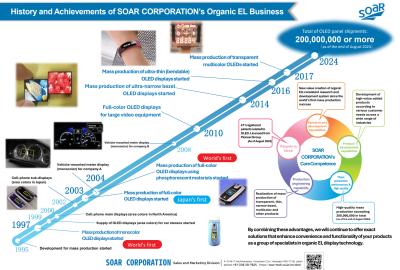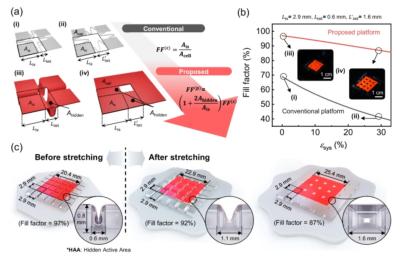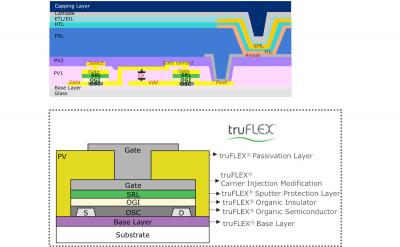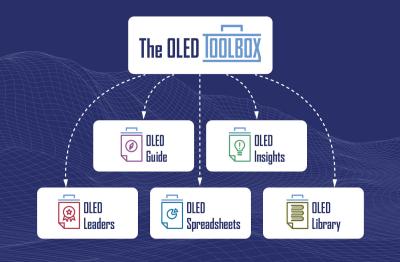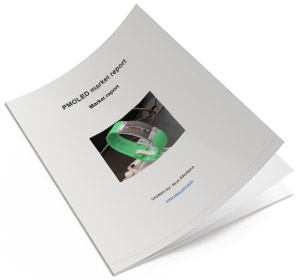PMOLED (Passive Matrix OLED): introduction and basics
OLED displays use organic materials that emit light when electricity is applied. OLEDs enable emissive, bright, thin, flexible and efficient displays. OLEDs are set to replace LCDs in all display applications - from small displays to large TV sets.
PMOLED: Passive Matrix OLED
PMOLED stands for Passive-Matrix OLED, which relates to the way you control (or drive) the display. A PMOLED display uses a simple control scheme in which you control each row (or line) in the display sequentially (one at a time). PMOLED electronics do not contain a storage capacitor and so the pixels in each line are actually off most of the time. To compensate for this you need to use more voltage to make them brighter. If you have 10 lines, for example, you have to make the one line that is on 10 times as bright (the real number is less then 10, but that's the general idea).

A PMOLED panel by Univision
So while PMOLEDs are easy (and cheap) to fabricate, they are not efficient and the OLED materials suffer from lower lifetime (due to the high voltage needed). PMOLED displays are also restricted in resolution and size (the more lines you have, the more voltage you have to use). PMOLED displays are usually small (up to 3" typically) and are used to display character data or small icons: they are being used in wearable devices, small gadgets and sub displays

PMOLED vs AMOLED
The other kind of OLED display is called an AMOLED (or Active-Matrix OLED). An AMOLED uses a TFT that contains a storage capacitor which maintains the line pixels lit all the time (even though just one line is changed each time). AMOLEDs consume less power than PMOLEDs, have faster refresh rates and allows to build larger display with higher resolutions. AMOLEDs are also more complicated and expensive to fabricate.

AMOLEDs today are being used as displays for smartphones, monitors, laptops, tablets - and TVs.
Flexible and transparent PMOLEDs
Some small and simple flexible (conformable) PMOLED displays are already on the market. Japan's Futaba for example is producing several such displays, including a 1.4" 128x16 film PMOLED display adopted in several fitness bands from Garmin, HTC and others. Some PMOLED makers have also commercialized small transparent PMOLED displays.

Looking for PMOLED suppliers?
Are you looking to adopt an PMOLED display for your device? Today there are several PMOLED producers (mostly in China and Taiwan), each making their own kinds of standard and custom PMOLED displays, with a total of dozens of different displays on the market.
The OLED Marketplace is our very own comprehensive OLED catalog, in which you can find most of the PMOLED displays on the market. Click here to browse our extensive catalog.
Further reading
- Introduction to OLEDs
- OLED Technology explained
- AMOLED Displays
- Flexible OLEDs
- The OLED Marketplace, but your PMOLED here
- The OLED Toolbox: our one-stop-shop for OLED information
SOAR says it shipped over 200 million OLED displays, since it began production in 1997
SOAR Corporation announced that it has shipped 200 million PMOLED displays. SOAR produces a range of PMOLED displays, focusing on wearables, audio systems, communication equipment, home appliances and automotive applications. The company also offers custom transparent and flexible displays.
SOAR was spun-off from Pioneer Corporation in 2022 and handle's Pioneer's PMOLED production business. Pioneer was the first company produce OLED displays, back in 1997. It is also the first company to use PHOLED materials (back in 2004).
Researchers develop a stretchable OLED design that utilizes hidden pixels to enable high quality images even after deformation
Researchers from Korea's KAIST, ETRI, and Dong-A University propose a new stretchable OLED display architecture, based on a 3D form that includes hidden sections that act both as active emitting areas and interconnectors. The idea is that as the OLED display is stretched, these areas pop into place and add to the emitting area of the OLED. The areas are basically hidden pixels that are only used when the display stretches.
To create this OLED device, the researchers attached ultrathin OLED films to a 3D rigid island array structure through quadaxial stretching, enabling precise, deformation-free alignment. The researchers explain that a portion of the ultrathin OLED is concealed by letting it ‘fold in’ between the adjacent islands in the initial, non-stretched condition and gradually surfaces to the top upon stretching.
RitDisplay to produce OTFT-driven AMOLED displays by 2026 in collaboration with Smartkem
UK-based OTFT display backplane developer SmartKem announced that it signed a collaboration agreement with based PMOLED-maker RiTdisplay, for the production of OTFT-based AMOLED displays. SmartKem further said that Innovate UK and the Taiwanese Ministry of Economic Affairs will support this project with a grant of around $530,000.
Smartkem will provide its proprietary OTFT materials to RiTdisplay to integrate within its OLED displays. If successful, the project will create the world's first commercially ready AMOLED display made using organic transistors, which will outperform RiT's PMOLEDs with higher brightness, lower power consumption and higher resolutions. Both companies hope that the project will be completed in 2026.
OLED-Info launches The OLED Toolbox, a revolutionary information product for the OLED industry
We are happy to launch The OLED Toolbox, a new information product for the OLED industry that provides an unprecedented depth of OLED content, data, analysis and insights, written and compiled by the industry's leading portal, OLED-Info.com.
The OLED Toolbox presents an unparalleled array of resources, including guides, projections, analyses, and profound insights into the world of OLED displays and lighting. Never before has it been so easy to gain access to a complete OLED industry resource!
What you'll find inside
- OLED Guide: an expert guide to OLED technologies, the OLED market and the OLED industry, covering everything you need to know about OLEDs
- OLED Insights: OLED analysis and insights, covering all the latest and future trends and developments in the OLED industry
- OLED Spreadsheets: excel files with detailed information on the OLED market and industry (including OLED devices, fabs, microdisplays, automotive solutions and more)
- OLED Leaders: In-depth articles by leading OLED professionals to discuss industry and market topics
- OLED Library: Over 160 content items by industry players - brochures, catalogs, roadmaps, presentations and more.
Qingyue shows new transparent PMOLED displays and OLED microdisplays at Display Week 2023
China-based PMOLED maker Qingyue (previously part of Visionox) demonstrated its latest OLED and ePaper displays at Display Week 2023.
So first up Qingyue showed a large transparent segmented PMOLED display, this is the largest PMOLED ever demonstrated at 20.6" in size. It did not detail the transparent level, but this looked very good and was quite impressive.
A new version of OLED-Info's PMOLED Market report released
Today we published a new edition of our PMOLED Market Report, with all the latest information. The new edition includes the latest changes from Pioneer (now called SOAR), Futaba, Wisechip and more.
Reading this report, you'll learn all about:
- Applications of PMOLED displays
- Next generation PMOLED technologies
- Flexible and transparent PMOLEDs
- AMOLED vs PMOLED
The report package also provides:
- Information on all PMOLED producers
- Current and future PMOLED fabs
- Display catalogs and datasheets
- Free updates for a year
This PMOLED market report provides a detailed introduction to PMOLED technologies and covers everything you need to know PMOLED displays, now and in the future. This is a great guide for anyone who's thinking about adopting PMOLED displays in their products or wants to offer products and services to the OLED industry.
A new version of OLED-Info's Automotive OLED Market report released
Today we published a new edition of our Automotive OLED Market Report, with all the latest information. The new edition includes three new car models, updates from Samsung, JDI and JOLED, new market forecasts and more. The adoption of OLED technologies by the automotive is accelerating and expected to continue in the future.
Reading this report, you'll learn all about:
- OLED advantages and challenges
- PMOLED and AMOLED displays adopted in cars today
- Why OLED lighting is exciting for car makers
- All about flexible and transparent OLEDs
The report package also provides:
- A directory of all OLED automotive display makers
- OLED lighting roadmaps
- Personal contact details into leading OLED produces
- Car concepts with OLED technologies
- Free updates for a year
This OLED Automotive market report provides a great introduction to OLED display and lighting solutions for the automotive industry. This is a great guide for anyone involved with the automotive market - car makers, suppliers and aftermarket solutions.
Wisechip announces its second TADF/HF PMOLED device
PMOLED display maker Wisechip has launched its second TADF/HF OLED display, a 5.5" 256x64 yellow PMOLED device. The company says that by using Kyulux's Hyperfluoresence™ OLED technology it offers double the brightness compared to its standard OLEDs.
Wisechip is the first and only company to commercialize TADF/HF device. The company's first device was launched in 2020, a 2.7" yellow PMOLED.
Wisechip demonstrates a new miniature PMOLED-based near-eye display
Wisechip has unveiled a new miniature near-eye display module that is based on a small PMOLED display. The company says that this cost-effective solution offers high-contrast and low-power, and can be used for rapid development and applications that only require a simple information display.
The display module combines a 0.19" monochrome (white) PMOLED display, and a small optical system. Wisechip says that the whole module can work up to 20 hours powered by a 70mAh lithium battery.
Futaba expands its strategic relationship with RiTDisplay for the production of PMOLED displays
Japan-based PMOLED maker Futaba announced that it is entering a business partnership agreement with Taiwan-based PMOLED maker RiTDisplay for the production of OLED displays.

Futaba is already collaborating with RiTDisplay for parts of the PMOLED production process, but now it will expand this project and move the entire PMOLED production process to RiT Display. The two companies will also partner to share technical details and co-develop and market automotive PMOLED displays.
Pagination
- Page 1
- Next page
